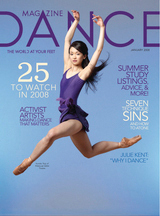 The Party’s Over! …But not for Joe Langworth!
The Party’s Over! …But not for Joe Langworth!
He has substituted a desk for a stage and has become a casting director.
By Phyllis Goldman
 “I thought I would be superhuman, dance until 50,” Joe Langworth reminisces about his transition from Broadway gypsy to casting director. “What I didn’t fully realize was that all athletes have a shelf life. And so did I.”
“I thought I would be superhuman, dance until 50,” Joe Langworth reminisces about his transition from Broadway gypsy to casting director. “What I didn’t fully realize was that all athletes have a shelf life. And so did I.”
After 20 years of professional dancing, mostly on Broadway, Langworth discovered the “fire had gone out in his belly.” After being invincible to the grueling but satisfying profession for all those years: showing up at auditions, processing rejections, being in shows that made it, shows that didn’t, opening nights, closing nights, his body began to tell him, “I don’t feel the same way anymore.” For some this is a rude awakening, but in the back of Langworth’s mind lurked the possibility of being on the other side of the footlights sometime in the near future. The casting field had always intrigued him. When the time came to curtail his dance career, casting was the first choice.
Because he had accepted a job as an assistant director and choreographer in a regional production of South Pacific, which was to begin in two months, he had the time to investigate the casting possibility offered to him at Bernard Telsey and Company as a non-paying intern. His friend Craig Burns at Telsey extended the invitation and emphasized that his knowledge of musical theater, gleaned through his years as a performer, would be invaluable in learning the casting business.
“This was a perfect scenario for me,” Langworth said. “If I don’t like it, I do have the other job coming up. But I discovered I loved the process, and with all my contacts it became easy and fun. Two months as an intern, then fulfilling my job obligation with South Pacific, and I was ready for my new career.”
What exactly is casting? It has to be much more than just “thank-you very much”, or “leave your picture and resume on my desk”, or “we’ll be in touch,” all the usual responses. “Actually, the responsibility is daunting,” Langworth began. “We are there to serve the choreographer and director, to share a vision of the show, most importantly to serve the needs of the creative team. I attend all the casting calls, and pay attention to everything that goes on. I feel fortunate to have the understanding of a dancer/choreographer and also of a performer. Often a dancer will need a little more information to understand what he is supposed to be doing. Dancers are an invaluable part of the business and are not always made to feel that way. I try to change that.”
There is an integral humanity that former dancers can bring to the casting business…a “having been there-done that” understanding. Langworth projects warmth and a giving personality that was clearly invaluable to the Telsey organization, and transferred as a comfort to the performer up there trying his best. “Yes, I know what it feels like to be so vulnerable, but I have to impress on my clients that they must trust themselves,” he noted. “Who you are and what you bring is enough. No one can be you, and you can’t be anyone else. You have to invest in who you are and not give us a version of what you think we want to see.” Langworth used the word “passion” as related to the dancer and the picture he creates at an audition. “Passion is appealing and contagious. When it is your turn to dance let it go. Have fun. Step out and be noticed.”
Langworth admits most of his jobs on Broadway came through open calls. He would consult the trade papers and read the breakdowns carefully before deciding, “Am I right for that?” His casting director traits were at work even then though he did not recognize them as leading to a new career. He feels strongly that dancers and actors must protect their ego and self-respect. “Don’t show up for a call for 5’2″ blonde if you are a statuesque brunette. Don’t show up at a call for a big hunky football player type if you are a 5’6″ cheerleader type. It won’t work. The creative team knows what they want.” On the other hand, if the dancer comes to an audition and has been kept to the end but isn’t exactly right for the show and is eliminated. Langworth advises that you take heart. “We have had instances where a producer or choreographer will say ‘Remember that girl who showed up at the audition last year and we didn’t take her but we liked her. Find her picture and résumé and give her a call for this show.”
“I came to dancing relatively late,” Langworth recalled, “and my physicality was not that of a ballet dancer. But when I was accepted to the Central Pennsylvania Youth Ballet for a summer program, I worked feverishly to build my technique. I went to SUNY Geneseo near Rochester because they offered a good dance and theater program. It is a challenge to get off the stage and acclimate to an office, yet I now have time I never had before. I can spend weekends with my family, see a friend for dinner at night, take a vacation…. all these things that are not part of our lives when you are a dancer in a show.” He is currently working as a casting director on an upcoming Lincoln Center revival of South Pacific, a big step forward for him in his new career.
Advising dancers in transition is something Langworth does willingly because he knows it is such a tough time. “Don’t worry about long term,” he emphasized. “Follow your heart and you will end up in a good place. A transition is daunting, leaving the dancing shoes behind is scary, but dancers have an incredible work ethic and make the best interns. Give them a 5-6-7-8, and they are ready.”